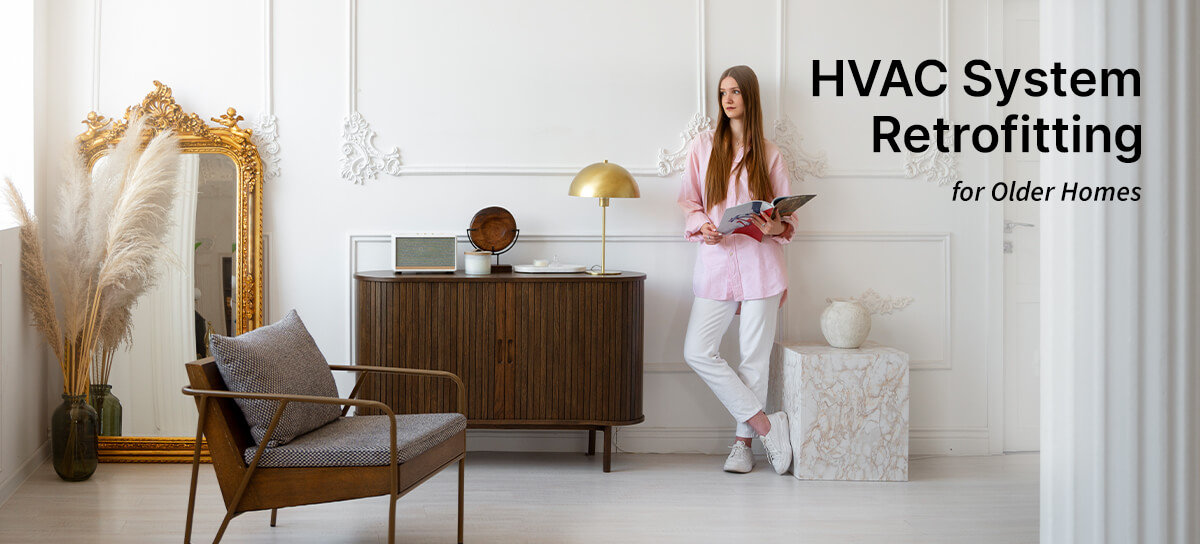
Older homes don’t lack in charm and history. Where they do fall short, however, is being energy efficient.
Did you know that:
Typical duct system in a home can lose between 20% to 30% of the air that moves through it due to leaks, holes, and poorly connected ducts?
About 48% of energy usage in an average home, and much of this energy can be wasted due to inefficient systems?
On average, homeowners spend around $400 to $600 per year on HVAC repairs, and these costs can be even higher for older systems?
These are staggering numbers. Especially in the face of a global climate crisis.
Many homes, especially those with historic or vintage significance, face challenges with outdated HVAC systems. In today’s blog post, we will explore the benefits of retrofitting older homes for more advanced HVAC systems.
There are several benefits that come from upgrading outdated HVAC systems, such as improved energy efficiency, enhanced comfort, and a positive impact on the environment.
We understand how this task can seem daunting and overwhelming at best. We are here to support you through this process. Our highly-skilled team is one phone call or email away, so don’t be afraid to reach out if you’re considering retrofitting your older home with advanced HVAC systems.
Older homes’ HVAC systems face many limitations. These limitations contribute to inefficient energy usage, inconsistent temperature control, and inadequate indoor air quality. Homeowners might experience a multitude of issues because of this, such as uneven heating or cooling, noisy operation, and high utility bills.
Outdated HVAC systems affect energy efficiency and comfort. Older systems often lack modern features such as variable-speed fans, smart thermostats, and energy-efficient components. This results in higher energy consumption, increased operating costs, and less precise control over indoor temperatures.
There are many positive outcomes that HVAC system retrofitting can bring. Some of them include:
There are many benefits of retrofitting an older home. Some include:
Now that you understand the need for retrofitting and we’ve further explored the many benefits of doing so, let’s look at some options available to you.

By installing a modern, energy-efficient furnace or boiler, the heating efficiency of an older home can be greatly improved. These advanced systems are designed to use fuel more effectively, resulting in better energy utilization and lower heating costs. One key indicator of efficiency is the AFUE (Annual Fuel Utilization Efficiency) rating, which represents how much fuel is converted into usable heat. Higher AFUE ratings signify less wasted energy and better overall performance, making such upgrades an effective solution for older homes seeking enhanced heating efficiency.
Upgrading to high SEER (Seasonal Energy Efficiency Ratio) air conditioning units offers notable benefits, particularly in hot months. These units are designed to cool homes more efficiently, using less energy to achieve the desired indoor temperature. Their advanced technology and higher SEER ratings indicate improved cooling performance, translating to reduced energy consumption, lower utility bills, and a more comfortable living environment, especially when temperatures soar.
Addressing outdated ductwork through retrofitting or replacement can have significant benefits for a home's HVAC system. This process involves fixing air leaks, enhancing airflow, and achieving a more balanced distribution of heated or cooled air throughout the house. By improving ductwork, homeowners can enjoy consistent temperatures in all rooms and potentially reduce energy waste, ultimately leading to a more comfortable and energy-efficient living environment.
Integrating zone control systems into HVAC upgrades provides homeowners with tailored heating and cooling solutions. With these systems, temperatures in different parts of the home can be adjusted separately, enhancing personalized comfort. This not only accommodates individual preferences but also contributes to energy savings by directing heating or cooling only where needed, making it an efficient and customizable solution for optimizing home comfort. We’ve written an entire blog post on this topic, so be sure to read it here.
The benefit of installing programmable thermostats is that they can adapt to your daily schedule by changing temperatures. This helps save energy by avoiding unnecessary heating or cooling when you're not home. These smart thermostats can also work with older heating and cooling systems, making it easier to control them remotely and potentially saving you money while improving how well the system works.
Installing air purifiers and ventilators can significantly enhance indoor air quality by effectively removing allergens, dust, and pollutants. These enhancements create a healthier living environment by reducing the presence of irritants that can affect respiratory health.
For instance, older homes often harbor allergens like dust mites, mold spores, and pet dander, along with pollutants like volatile organic compounds (VOCs). Retrofitting with air purifiers and ventilators can help reduce these contaminants, making the air cleaner and promoting better respiratory well-being for everyone living in the home.

Retrofitting HVAC systems involves comparing the upfront costs to the long-term gains. Although retrofitting requires an initial investment, the benefits over time like lower energy bills, decreased maintenance costs, and increased home value can outweigh the initial spending.
By investing in retrofitting, homeowners can gradually recover their expenses through energy savings over the years. This can be seen in specific examples or case studies that highlight how retrofitting has helped homeowners enjoy significant savings on energy bills in the long run.
Exploring the financial incentives for retrofitting HVAC systems reveals several ways homeowners can save money. These include rebates from utility companies, government incentives, and tax credits for energy-efficient upgrades. Accessing these benefits can substantially reduce the retrofitting costs, making the decision to upgrade more financially attractive. To access these incentives, homeowners can typically visit official websites, contact utility providers, or consult tax professionals to ensure they take full advantage of available savings.
When it comes to financing, homeowners have several options to ease concerns about the upfront cost of retrofitting. These include tapping into home equity through loans or lines of credit, which typically come with lower interest rates. Specialized energy-efficiency loans can also be considered, offering favourable terms and lower interest rates specifically for home improvements. Additionally, there are lease or financing programs available through HVAC companies or third-party organizations, enabling homeowners to spread out the retrofitting costs over time, making the process more affordable.
At Advance Heating and Cooling, we have one goal — to empower our customers to make energy-efficient choices for their homes and workplaces through optimized HVAC systems. Energy consumption is both a global imperative and a community effort. Every effort matters in reducing carbon emissions and in turn, lowering living costs.
We understand how the task of retrofitting an older home can seem daunting and overwhelming at best. We are here to support you through this process. Our highly-skilled team is one phone call or email away, so don’t be afraid to reach out if you’re considering retrofitting your older home with advanced HVAC systems.
